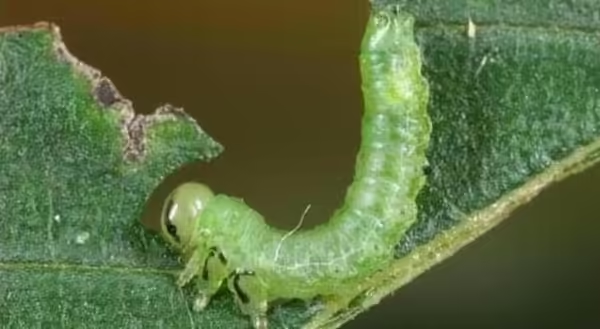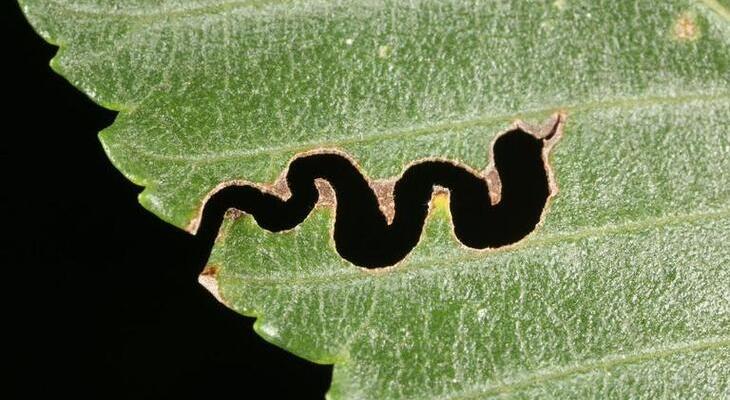
The elm zigzag sawfly (Aproceros leucopoda) is an invasive pest of elm trees (Ulmus spp.) that was first detected in Illinois in July 2024 in Busse Woods, Cook County. Native to parts of China and Japan, this species became established in Europe in 2003 and was first detected in the United States in Virginia in 2021. Since then, it has expanded its range into North Carolina, up the East Coast, and westward, reaching Wisconsin, Minnesota, and Illinois by 2024. Adult elm zigzag sawflies can extend their range by 28–56 miles per year, a rapid expansion attributed to their strong dispersal capabilities.
Identification and Damage
Sawflies are related to wasps but lack the narrow “waist” characteristic of true wasps. They undergo complete metamorphosis, progressing through egg, larva, pupa, and adult stages. The North American population of elm zigzag sawfly consists exclusively of females, which reproduce via parthenogenesis, laying viable eggs without mating. A single female can lay between 7-49 eggs, typically along the serrated edges of elm leaves. Larvae hatch within 4–8 days, emerging at approximately 1.8 mm in length and growing to 10–11 mm by the end of their sixth instar. They resemble light green caterpillars with a brown head band and distinctive T-shaped markings on the back of two of their three pairs of true legs. Larval sawflies possess six or more prolegs behind their true legs, distinguishing them from lepidopteran caterpillars, which typically have five or fewer pairs of prolegs. During the summer, larvae pupate in loose cocoons on the undersides of leaves. Overwintering pupae form denser cocoons within leaf litter. Adult sawflies are compact, dark-colored insects measuring 6–7 mm long, with white to yellow legs. While elm zigzag sawflies can have 1–6 generations per year, the exact number in the U.S. remains unknown, likely variable depending on the region and year.
Elm zigzag sawflies are primarily problematic through larval defoliation. They feed exclusively on elm species, including American, Chinese, English, Siberian, slippery, winged, and various elm hybrids. Early instars feed in a characteristic zigzag pattern between small leaf veins, often beginning at the leaf edge. As larvae mature, feeding patterns become less distinct, and more leaf material is consumed. While light infestations may be overlooked, heavier populations can lead to extensive defoliation. Though most healthy trees can recover, repeated defoliation from large infestations can cause branch dieback and increase susceptibility to other stresses.
Reporting
In Illinois, the elm zigzag sawfly has only been confirmed in Busse Woods, Cook County; however, surveillance from this spring has captured individuals spreading from the site of the original infestation. If you suspect defoliation on your elm tree caused by elm zigzag sawfly, either by observing the distinctive zigzag feeding pattern or spotting the larvae, please report your sighting to your local Extension office or email invasives@illinois.edu. Include the location (with precise coordinates, if possible), the date of observation, and clear photos of the larvae or feeding damage to aid in identification. Remember that elm zigzag sawfly has only been recorded feeding on elms, so similar feeding damage on non-elm tree species is not likely to be caused by the invasive. Reporting suspected cases is the most effective way Illinois residents can support efforts to monitor and manage the spread of elm zigzag sawfly.
Management
Control of elm zigzag sawfly is still being studied due to its recent arrival and the lack of necessity for control in its native range. In Eastern Europe, deltamethrin and teflubenzuron were effective against first and second-instar larvae (Blank et al. 2010). The entomopathogenic fungus Beauveria bassiana (Bals.) Vuill has also been found to cause dose-dependent mortality in invasive populations in Europe (Fătu et al. 2021). In the U.S., research out of Virginia demonstrated that dinotefuran can provide up to 83% control of larvae via foliar application (Del-Pozo et al. 2021). While other insecticides labeled for sawfly control may offer efficacy against elm zigzag sawfly, most have not yet been rigorously tested, and control is not guaranteed.
References:
Blank SM, Hara H, Mikulás J, Csóka G, Ciornei C, Constantineanu R, Constantineanu I, Roller L, Altenhofer E, Huflejt T, et al. . Aproceros leucopoda (Hymenoptera, Argidae): an East Asian pest of elms (Ulmus spp.) invading Europe. Eur J Entomol. 2010:107(3):357–367. https://doi.org/10.14411/eje.2010.045
Del Pozo-Valdivia AI, Calpo D, Sutphin M. Effect of afidopyropen and dinotefuran on elm zigzag sawfly control. Arthropod Manag Tests. 2021:47:1. https://doi.org/10.1093/amt/tsac122
Fătu A C, Cardaş G, Ciornei C, Andrei A M. Experimental field application of Beauvaria bassiana (Bals.) Vuill. for control of the invasive sawfly Aproceros leucopoda Takeuki, 1939 (Hymenoptera: Argidae) in Romania. Acta Zool Bulg. 2020:72:661–666.
Oten KL, Day E, Dellinger T, Disque HH, Barringer LE, Cancelliere J, Somers L, Bertione MA. First records of elm zigzag sawfly (Hymenoptera: Argidae) in the United States. J Int Pest Mgmt. 2023:14:1-12. https://doi.org/10.1093/jipm/pmad009
Photo credit: Elm zigzag sawfly (Aproceros leucopoda) larva, Gyorgy Csoka, Hungary Forest Research Institute, Bugwood.org
Elm zigzag sawfly (Aproceros leucopoda) damage, Gyorgy Csoka, Hungary Forest Research Institute, Bugwood.org
ABOUT THE AUTHOR: John Schepis provides subject matter expertise and training in pesticide safety with an emphasis on entomology.
